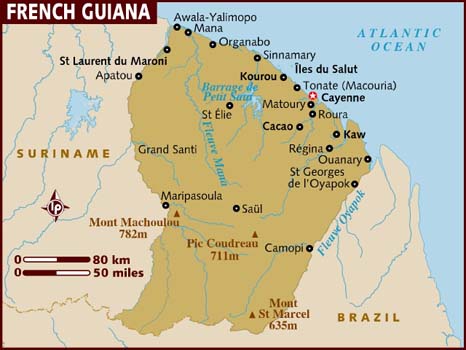Population: 290 000 (2019)
Area: 83 534 km²
Since 1981, when Belize became independent, French Guiana has been the only territory of the mainland Americas that is still part of a European country.
With a land area of 83,534 km2 (32,253 sq mi), French Guiana is the second-largest region of France and the largest outermost region within the European Union. It has a very low population density, with only 3.4 inhabitants per square kilometre (8.8/sq mi).
Since December 2015 both the region and the department have been ruled by a single assembly within the framework of a new territorial collectivity, the French Guiana Territorial Collectivity. This assembly, the French Guiana Assembly, has replaced the former regional council and departmental council, which were both disbanded. The French Guiana Assembly is in charge of regional and departmental government. Its president is Rodolphe Alexandre.
Currency
The Euro is the official currency of French Guiana.
You may exchange your money for the Euro at most Cayenne banks or at specialized stores called Foreign Exchange Bureaus. Look for signs that say Bureau De Change, Geld Wechseln or Cambio. You may be able to exchange your money at the Cayenne airport, but exchange rates may not be the best. You should consider purchasing the Euro currency at a more favorable exchange rate before you arrive in Cayenne. You can do that by researching online currency brokers that do foreign exchange. If on holiday, vacation, or business you can also inquire about purchasing travellers checks (Travellers Cheques). Also, before your trip, consult with your credit or debit card bank about the foreign exchange transaction fees charged for using your card in Cayenne, Fr. Guiana.
Climate
Located within six degrees of the Equator and rising only to modest elevations, French Guiana is hot and oppressively humid all year round. During most of the year, rainfall across the country is very heavy due to the presence of the Intertropical Convergence Zone and its powerful thunderstorm cells. In most parts of French Guiana, rainfall is always very heavy from December to June or July – typically over 330 millimetres or 13 inches can be expected each month during this period throughout the department. Between August and November in the eastern half is a "dry" season with as little as 30 millimetres or 1.18 inches in September and October typical in many areas, causing eastern French Guiana to be classed as a tropical monsoon climate (Köppen Am); the west Saint-Laurent-du-Maroni has a tropical rainforest climate (Af).
Languages
The official language of French Guiana is French, and it is the predominant language of the department, spoken by most residents as a first or second language. In addition, a number of other local languages exist. Regional languages include Guianan Creole, six Amerindian languages (Arawak, Palijur, Kali'na, Wayana, Wayampi, Emerillon), four Maroon creole languages (Saramaka, Paramaccan, Aluku, Ndyuka), as well as Hmong Njua. Other languages spoken include Portuguese, Hakka, Haitian Creole, Spanish, Dutch, English, and Tamil, and Caribbean Hindustani.
Economy
As a part of France, French Guiana is part of the European Union and the Eurozone; its currency is the euro. The country code top-level domain (ccTLD) for French Guiana is .gf, but .fr is generally used instead.
In 2016, the GDP of French Guiana at market exchange rates was US$4.86 billion (€4.39 billion), ranking as the largest economy in the Guianas, and the 11th largest in South America.
French Guiana is heavily dependent on mainland France for subsidies, trade, and goods. The main traditional industries are fishing (accounting for 5{0244406ce177f5d61215fd6f63981e011f40227bc18a8b3383afaea656b64ad9} of exports in 2012), gold mining (accounting for 32{0244406ce177f5d61215fd6f63981e011f40227bc18a8b3383afaea656b64ad9} of exports in 2012) and timber (accounting for 1{0244406ce177f5d61215fd6f63981e011f40227bc18a8b3383afaea656b64ad9} of exports in 2012). In addition, the Guiana Space Centre has played a significant role in the local economy since it was established in Kourou in 1964: it accounted directly and indirectly for 16{0244406ce177f5d61215fd6f63981e011f40227bc18a8b3383afaea656b64ad9} of French Guiana's GDP in 2002 (down from 26{0244406ce177f5d61215fd6f63981e011f40227bc18a8b3383afaea656b64ad9} in 1994, as the French Guianan economy is becoming increasingly diversified). The Guiana Space Centre employed 1,659 people in 2012.
There is very little manufacturing. Agriculture is largely undeveloped and is mainly confined to the area near the coast and along the Maroni River. Sugar and bananas were traditionally two of the main cash crops grown for export but have almost completely disappeared. Today they have been replaced by livestock raising (essentially beef cattle and pigs) in the coastal savannas between Cayenne and the second-largest town, Saint-Laurent-du-Maroni, and market gardening (fruits and vegetables) developed by the Hmong communities settled in French Guiana in the 1970s, both destined to the local market. A thriving rice production, developed on polders near Mana from the early 1980s to the late 2000s, has almost completely disappeared since 2011 due to marine erosion and new EU plant health rules which forbid the use of many pesticides and fertilizers. Tourism, especially eco-tourism, is growing. Unemployment has been persistently high in the last few decades: 20{0244406ce177f5d61215fd6f63981e011f40227bc18a8b3383afaea656b64ad9} to 25{0244406ce177f5d61215fd6f63981e011f40227bc18a8b3383afaea656b64ad9} (22.3{0244406ce177f5d61215fd6f63981e011f40227bc18a8b3383afaea656b64ad9} in 2012).
In 2016, the GDP per capita of French Guiana at market exchange rates, not at PPP, was US$17,961 (€16,230), the highest in South America, but only 48{0244406ce177f5d61215fd6f63981e011f40227bc18a8b3383afaea656b64ad9} of metropolitan France's average GDP per capita that year, and 56.5{0244406ce177f5d61215fd6f63981e011f40227bc18a8b3383afaea656b64ad9} of the metropolitan French regions outside the Paris Region.
Religion
The dominant religion of French Guiana is Roman Catholicism; the Maroons and some Amerindian peoples maintain their own religions. The Hmong people are also largely Catholic owing to the influence of missionaries who helped bring them to French Guiana.
In popular culture
The novel Papillon, by the French convict Henri Charrière, is set in French Guiana. It was first published in France in 1969, describing his escape from a penal colony there. Becoming an instant bestseller, it was translated into English from the original French by June P. Wilson and Walter B. Michaels for a 1970 edition, and by author Patrick O'Brian. Soon afterward the book was adapted for a Hollywood film of the same name.
Charrière stated that all events in the book are truthful and accurate, allowing for minor lapses in memory. Since its publication there has been controversy over its accuracy.
Geography
French Guiana lies between latitudes 2° and 6° N, and longitudes 51° and 55° W. It consists of two main geographical regions: a coastal strip where the majority of the people live, and dense, near-inaccessible rainforest which gradually rises to the modest peaks of the Tumuc-Humac mountains along the Brazilian frontier. French Guiana's highest peak is Bellevue de l'Inini in Maripasoula (851 m (2,792 ft)). Other mountains include Mont Machalou (782 m (2,566 ft)), Pic Coudreau (711 m (2,333 ft)) and Mont St Marcel (635 m (2,083 ft)), Mont Favard (200 m (660 ft)) and Montagne du Mahury (156 m (512 ft)).
Several small islands are found off the coast, the three Salvation's Islands which include Devil's Island, and the isolated Îles du Connétable bird sanctuary further along the coast towards Brazil.
The Petit-Saut Dam, a hydroelectric dam in the north of French Guiana forms an artificial lake and provides hydroelectricity. There are many rivers in French Guiana, including the Waki River.
As of 2007, the Amazonian forest, located in the most remote part of the department, is protected as the Guiana Amazonian Park, one of the ten national parks of France. The territory of the park covers some 33,900 square kilometres (13,090 sq mi) upon the communes of Camopi, Maripasoula, Papaïchton, Saint-Élie and Saül.
Getting Around
3,400km of French Guiana's waterways are navigable by native boats called pirogues. 460km is navigable by small ocean-going vessels and coastal and river steamers.
There is limited public transport throughout the territory. Minibuses go between major towns but there may only be a few per day. Fares are fixed per route; if only going partial distance to Cayenne you may have to pay the full fare. Eg. St. Laurent du Maroni to Kourou you may have to pay the full fare to Cayenne. Fare for St. Laurent to Cayenne is €50, for Kourou to Cayenne €10, Saint-Georges to Cayenne €40. There is a bus that runs from the airport to the centre of Cayenne, contact the people at the information desk at the airport to be sure the driver stops to pick you up.
There are numerous taxis. They are comfortable but very expensive. A journey from the airport to Cayenne would cost you €35 and the price for a taxi from Cayenne to Kourou could get as high as €85.
There are lots of possibilities for renting cars on the airport and in Cayenne and the other bigger villages.
Health
Vaccination against yellow fever is necessary.
Malaria is also a risk.
Stay Safe
It is advisable to pay extreme attention not to lose your passport: there are very few consulates in French Guiana as such services are provided by consulates in Paris, so you will be required to go to Paris in case you need your passport to be reissued if you are not an EU citizen.













